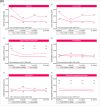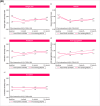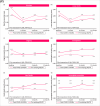Long-Term Impact of COVID-19 on Disorders of Gut-Brain Interaction: Incidence, Symptom Burden, and Psychological Comorbidities
- PMID: 40119532
- PMCID: PMC12188378
- DOI: 10.1002/ueg2.70005
Long-Term Impact of COVID-19 on Disorders of Gut-Brain Interaction: Incidence, Symptom Burden, and Psychological Comorbidities
Abstract
Background: The severe acute respiratory syndrome coronavirus 2 (SARS-CoV-2) pandemic has highlighted the potential exacerbation of gastrointestinal symptoms in patients with disorders of gut-brain interaction (DGBIs). However, the distinct symptom trajectories and psychological burden in patients with post-COVID-19 DGBIs compared with patients with pre-existing irritable bowel syndrome (IBS)/functional dyspepsia (FD) and non-DGBI controls remain poorly understood.
Objectives: To examine the long-term gastrointestinal symptom progression and psychological comorbidities in patients with post-COVID-19 DGBI, patients with pre-existing IBS/FD and non-DGBI controls.
Methods: This post hoc analysis of a prospective multicenter cohort study reviewed patient charts for demographic data and medical history. Participants completed the Gastrointestinal Symptom Rating Scale at four time points: baseline, 1, 6, and 12 months, and the Hospital Anxiety and Depression Scale at 6 and 12 months. The cohort was divided into three groups: (1) post-COVID-19 DGBIs (2) non-DGBI, and (3) pre-existing IBS/FD, with the post-COVID-19 DGBIs group compared to the latter two control groups.
Results: Among 599 eligible patients, 27 (4.5%) were identified as post-COVID-19 DGBI. This group experienced worsening abdominal pain, hunger pain, heartburn, and acid regurgitation, unlike symptom improvement or stability in non-DGBI controls (p < 0.001 for all symptoms, except hunger pain, p = 0.001). While patients with pre-existing IBS/FD improved in most gastrointestinal symptoms but worsened in constipation and incomplete evacuation, patients with post-COVID-19 DGBI exhibited consistent symptom deterioration across multiple gastrointestinal domains. Anxiety and depression remained unchanged in patients with post-COVID-19 DGBI, contrasting with significant reductions in controls (non-DGBI: p = 0.003 and p = 0.057; pre-existing IBS/FD: p = 0.019 and p = 0.007, respectively).
Conclusions: COVID-19 infection is associated with the development of newly diagnosed DGBIs and distinct symptom trajectories when compared with patients with pre-existing IBS/FD. Patients with post-COVID-19 DGBI experience progressive gastrointestinal symptom deterioration and persistent psychological distress, underscoring the need for tailored management strategies for this unique subgroup.
Keywords: COVID‐19; anxiety; depression; disorders of gut‐brain interaction; functional dyspepsia; gastrointestinal symptoms; irritable bowel syndrome; post‐infection gastrointestinal disorders.
© 2025 The Author(s). United European Gastroenterology Journal published by Wiley Periodicals LLC on behalf of United European Gastroenterology.
Conflict of interest statement
The authors declare no conflicts of interest.
Figures







References
-
- Cheung K. S., Hung I. F. N., Chan P. P. Y., et al., “Gastrointestinal Manifestations of SARS‐CoV‐2 Infection and Virus Load in Fecal Samples From a Hong Kong Cohort: Systematic Review and Meta‐Analysis,” Gastroenterology 159, no. 1 (2020 July): 81–95, 10.1053/j.gastro.2020.03.065. - DOI - PMC - PubMed
Publication types
MeSH terms
Grants and funding
LinkOut - more resources
Full Text Sources
Medical
Miscellaneous

